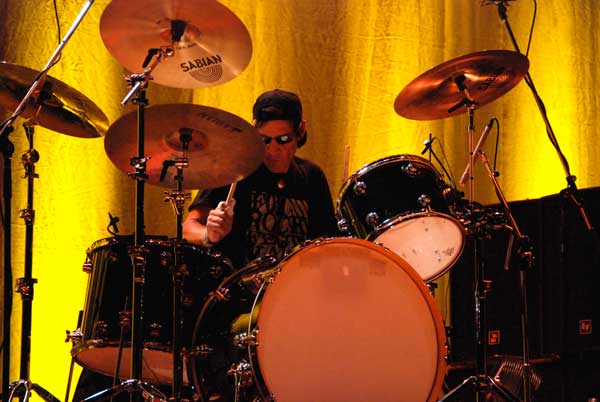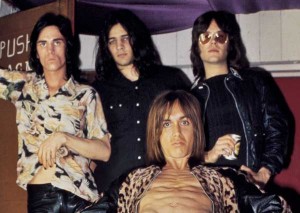Stooges Drummer Scott Asheton Passes

By Robert Matheu
Modern Drummer learned of the death this past weekend of Scott Asheton, drummer with the seminal Ann Arbor, Michigan, band the Stooges; his passing was noted in several media reports and on Stooges singer Iggy Pop’s Facebook page. In honor of Asheton’s unique place in rock ’n’ roll history, we’re reprinting our September 2010 feature on him here.
Scott Asheton
by Brett Callwood
Think about the Stooges, and it’s inevitable that, like it or not, Iggy Pop’s snakelike figure will slither into your mind. Without the Asheton brothers, however, the Stooges would not have had the impact they did.
Ron Asheton created a whole new way to play the guitar, one that wasn’t necessarily based on technical proficiency, at least not in the conventional view. There was no precedent for his playing, nobody that he was looking to and borrowing riffs from. Similarly, without Scott Asheton’s primal, instinctive approach to the drums, the Stooges would have sounded completely different. Advertisement
When they started in the late ’60s, the Stooges were unlike any band that had ever convened in a basement and thrashed out a song. Initially called the Psychedelic Stooges, the group would create instruments out of household appliances such as vacuum cleaners and just make noise for thirty minutes to an hour, to the annoyance or intrigue of anyone in attendance. Writing a chapter for himself in rock lore, Iggy Pop took the overt sexual movements of Jim Morrison and Mick Jagger to a new level, often including violence in the mix. But without the Asheton brothers, Pop would have been just a crazy guy at college parties.
Scott Asheton was born in 1948, a year after his brother, Ron. The family would move around a lot, but, when father Ronald passed away prematurely in 1963, Ann Asheton would settle with her two sons in Ann Arbor, Michigan. It was a relatively happy upbringing for the brothers, and it was at school that Scott was introduced to the drums. “The teachers would look over the class and decide what everyone would play,” Asheton recalls. “The overweight guys would play the big horns, and the athletic guys would get the drums. So I was kind of told I would be playing the snare drum. At some stage I wanted to switch to guitar, but my mom wouldn’t let me. She said, ‘You picked the drums, now stick with it.’”
In high school, Scott and Ron became friends with future Stooges bassist Dave Alexander. Along with another friend, Billy Cheatham, they formed a garage band called the Dirty Shames. Asheton remembers the group had more ego than ambition. “We didn’t get very far,” the drummer says with a wry smile. “We liked the idea of being in a band, we looked like we were in a band, and we’d all hang out together. However, it wasn’t until Jim [Osterberg, aka Iggy Pop] got involved that it actually became a real band.” Advertisement
In Osterberg, Ron and Scott knew they had on their hands a frontman with the potential to shock and titillate in equal measure. Says Asheton, “I was impressed by how many girls would just follow him. He only had to walk across campus, and there’d be five girls walking behind him, all giggling. Talk about a magnet.”
Their instincts were right. Osterberg, who would soon earn his stage name simply because he had played drums in a pop band called the Iguanas—yes, Iggy Pop was initially a drummer—was only too happy to join up with the brothers and Alexander, and the Psychedelic Stooges were born. Initially, the group played at college parties for whoever was drunk enough to watch. While the rest of the band was making noises with vacuum cleaners and power tools, Scott Asheton was banging away on whatever he could get his hands on. “My toms were timbales,” he says. “I had fifty-gallon oil drums for my bass drums, a regular snare drum, and regular cymbals. It was the oil drums that set everything apart.
“I really enjoyed playing with Dave,” Asheton continues. “When the band first started out, we technically didn’t have a bassist. We did have a Kustom bass amp, though, and we’d turn the volume and reverb all the way up, lift the head up off the cabinet, and drop it. It made this terrific sound. Dave’s first job was picking up the amp head and dropping it on the cabinet to make that big sound.” Advertisement
Now simply called the Stooges, the group managed to get signed to Elektra Records when “big-brother band” the MC5 secured a deal and guitarist Wayne Kramer suggested the Stooges to the label. But when it came time to record a debut album in 1969, it soon became apparent that the Stooges’ structure-less party noise wasn’t going to please the suits at Elektra HQ.
“[The recording] was just so fast because we had to change the band overnight,” Asheton remembers. “The label gave us a week or two to figure out how to record, because they’d told us we had to write some songs. We thought we had songs, but they said our material would be too hard to record. So a lot of that first album was written at the Chelsea Hotel in New York City over two days, immediately before we went into the studio. A lot of the songs that we recorded we’d never played before, ever. One song, ‘Real Cool Time,’ we went over in the hotel room the night before and decided to try recording the next day. The very first time we ever played it, they said, ‘Okay, that’s good. Next!’ So it was a really short time period for actually recording.”
The following year, having made little commercial headway with their self-titled debut, the Stooges returned to the studio to record Funhouse. Again, the album went by largely unnoticed by a record-buying public obsessed with guitar heroes like Jimmy Page and Eric Clapton. The world just wasn’t ready for the Stooges yet. Advertisement
With this in mind, Iggy Pop decided to shake up the band for the third album, 1973’s Raw Power, which would be recorded in England with David Bowie at the mixing desk. Alexander had been fired for turning up at a rehearsal too drunk to play (he would die prematurely in 1975 from a pulmonary edema), and, soon afterward, the Ashetons were also given the proverbial boot. James Williamson, a friend of Pop’s, came in on guitar. But when Pop was unable to find an adequate drummer and bass player in the U.K., the Ashetons were asked to rejoin, with Ron shifting from guitar to bass. For Scott, it was an odd time. “This was something my brother and I had worked at for years,” he says. “It was more our band than it was James’s. We were going to be put in a sideman position in our own band.”
The group would tour behind Raw Power, but the relationship between the four men had become strained, and soon afterward the Stooges ceased to exist. Iggy Pop would go on to have a successful solo career, while Williamson gave up music altogether. The Ashetons would soldier on throughout the ’70s, ’80s, and ’90s, playing in a variety of different projects.
For Scott Asheton, of note was Sonic’s Rendezvous Band, an act put together by former MC5 guitarist Fred “Sonic” Smith in the mid-’70s. The band would create a stir within the Detroit scene but would break up before recording an album. “I enjoyed playing with Fred very much, and we were getting really good,” Asheton says. “People were loving the band, but that’s when Fred met Patti [Smith] and the band fell apart. There would have been an album, but Patti came along at the perfectly wrong time.” Advertisement
The brothers sat and watched, perplexed, as countless groups under the punk banner would cite the Stooges as an influence and gain massive commercial success, while they were stuck in a rut. Later, when grunge hit in the ’90s, nearly every indie musician would give props to the Ashetons’ unconventional playing styles, but ego boosts don’t pay the bills.
Scott Asheton all but fell off the radar between 1980 and 2000, occasionally playing on records by Scott Morgan (of Detroit rockers the Rationals) and in Dark Carnival (featuring his brother and former Destroy All Monsters singer and artist Niagara). As the new millennium began, however, the Asheton brothers set out on tour with Dinosaur Jr. frontman J. Mascis and Minutemen bassist Mike Watt, playing Stooges material exclusively. The crowds lapped it up, and when Iggy Pop heard what was happening, a reunion became inevitable.
The Stooges re-formed in 2003, initially to record some songs for Pop’s album Skull Ring, but they played a show that year at the Coachella Festival, their first performance together in three decades. The band would later record a full record, The Weirdness, which would receive mixed reviews, but they nevertheless became more popular than they’d ever been, playing at festivals and sold-out theaters in front of thousands. Advertisement
That chapter of the band came to an end at the start of 2009, when Ron Asheton was found dead in his home, having suffered a heart attack. As Detroit and the rock ’n’ roll community in general mourned, many thought the Stooges’ story had once again reached its conclusion. But later that year the band made the decision to bring back James Williamson and continue, playing the Raw Power material.
Understandably, Scott has mixed feelings about that. “It wasn’t an immediate decision,” he says. “We kicked around ideas for guitar players that wanted to do it. Iggy and James were not even on speaking terms. Iggy was thinking the best way it would work would be if James was in the band, but he didn’t know if he would be able to deal with James. As it turned out, they’re getting along fine. [Ron] would probably not want to have anything to do with it. That bothers me. I try to get over it and not let it beat me up too much. I really miss playing with my brother.”
For many Stooges fans, the concept of once again experiencing the Raw Power lineup of Iggy & the Stooges, albeit with Mike Watt stepping into Ron Asheton’s shoes on bass guitar, is an exciting one. And, in fact, it has gotten significantly easier to behold the band in action. Sony recently reissued Raw Power in a deluxe edition that, in addition to including audio from a 1973 Stooges concert, features a documentary on the making of the album, with footage from back in the day as well as from the current lineup. We can only hope that projects such as this succeed in reminding the world what an iconoclastic band the Stooges are, and how integral to that revolutionary sound Scott Asheton’s drumming is. Advertisement



